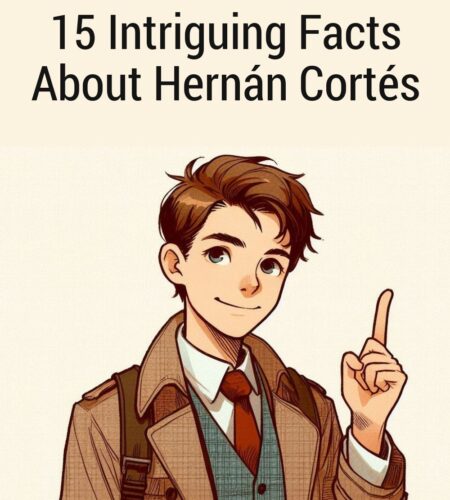Introduction:
In this article, we will delve into the fascinating life of Hernán Cortés, a Spanish conquistador who is best known for his conquest of the Aztec Empire and the subsequent colonization of Mexico. From his early explorations to his captivating encounters with indigenous civilizations, we will unveil 15 intriguing facts about this legendary figure who played a pivotal role in shaping the history of the Americas.
Fact 1: A Determined Explorer
Hernán Cortés was born in 1485 in Medellín, Spain. From a young age, he displayed a keen interest in exploration and adventure, and this voracious curiosity would later drive him to explore the uncharted territories of the New World.
Fact 2: The Power of Words
Cortés possessed exceptional oratory skills, which became one of his greatest assets during his encounters with the Aztec Empire. He was able to convey his intentions, grievances, and demands to both the indigenous people and his own men in a persuasive manner, often influencing their thoughts and actions.
Fact 3: The Man Behind the Myth
Contrary to popular belief, Cortés did not possess any supernatural abilities. His conquest of the Aztec Empire was primarily due to his strategic wit, resourcefulness, and the alliances he forged with indigenous groups who were tired of Aztec domination.
Fact 4: A Risk-Taker
During his conquest, Cortés burned the ships that brought him to Mexico. This audacious act left his men with no option but to move forward, as there was no turning back. It was a calculated risk that further fueled their determination to succeed.
Fact 5: A Technological Advantage
One significant factor that contributed to Cortés’ success was the advanced weaponry and armor possessed by the Spanish conquistadors. The Aztecs, with their conventional weapons, were no match for the superior arms of the Europeans, especially the devastating impact of firearms and cannons.
Fact 6: Montezuma’s Hospitality
While the Aztec emperor, Montezuma, initially believed Cortés to be the god Quetzalcoatl, it was also his sense of hospitality that allowed the Spanish conquistador to gain a foothold. Montezuma’s honor-bound traditions prevented him from treating Cortés with hostility, at least in the early stages of their encounter.
Fact 7: The Great Retreat
In 1520, during his absence from Tenochtitlan, Cortés’ men provoked an uprising known as the Noche Triste (Sad Night). The Aztecs fiercely attacked the Spanish conquistadors, forcing them to flee. This setback, however, did not deter Cortés from eventually conquering the empire in the following year.
Fact 8: Tenochtitlan’s Fall
In 1521, after months of intense battles and sieges, Cortés finally managed to capture Tenochtitlan, the capital of the Aztec Empire. The legendary Lake Texcoco, on which the city was built, became the stage for the downfall of one civilization and the rise of another.
Fact 9: Cultural Confluence
The conquest of Mexico brought about a profound cultural convergence. The Spanish colonization led to the fusion of European and indigenous traditions, resulting in a new hybrid culture that is evident in modern-day Mexican society.
Fact 10: The Encounter with La Malinche
During his expeditions, Cortés encountered the indigenous woman known as La Malinche. She became his trusted translator, advisor, and ultimately, his mistress, playing a pivotal role in facilitating communication between Cortés and the indigenous populations.
Fact 11: The Final Years
Following his conquest of Mexico, Cortés faced multiple challenges and controversies. Despite his significant accomplishments, he struggled to maintain his authority and was eventually stripped of some of his privileges by the Spanish crown. He lived out his remaining years in relative obscurity.
Fact 12: Legacy and Controversy
Cortés is a figure shrouded in controversy, with differing views on his actions and motivations. While some view him as a brave explorer and a pioneer of New World conquest, others criticize his brutality and the devastating consequences of European colonization.
Fact 13: Amarindian Resistance
Cortés faced fierce resistance from various indigenous groups throughout his conquest of the Aztec Empire. These groups were determined to defend their land, preserve their culture, and resist the encroachment of the Spanish colonizers.
Fact 14: Architectural Marvels
The architectural legacy left by the Aztec Empire remains a testament to their ingenuity and skill. Cortés and the Spanish conquistadors marveled at the grandeur of the Aztec temples, pyramids, and palaces while simultaneously subjugating them to ensure the rise of their own rule.
Fact 15: The Cortés Myth
The persona of Hernán Cortés has been immortalized in both historical accounts and popular culture. This larger-than-life figure continues to captivate our imagination, serving as a reminder of the complex and often conflicting forces that shaped the conquest of the New World.
Conclusion
Hernán Cortés’s expeditions and conquests left an indelible mark on the history of the Americas. Whether regarded as a visionary explorer or a ruthless conqueror, his life and actions highlight the collision of cultures and the profound effects of European imperialism on indigenous civilizations. By exploring his intriguing journey through these 15 facts, we gain insight into a pivotal chapter in human history.
Subscribe to our email newsletter to get the latest posts delivered right to your email.





Comments